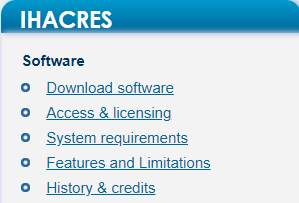Quoted from: https://toolkit.ewater.org.au/Tools/IHACRES
Purpose
IHACRES is a catchment-scale rainfall-streamflow modelling methodology whose purpose is to characterise the dynamic relationship between rainfall and streamflow, using rainfall and temperature (or potential evaporation) data, and to predict streamflow.
The model can be applied over a range of spatial and temporal scales - from small experimental catchments to basins; using minute, daily or monthly timesteps. It can be used to fill gaps in data, extend streamflow records, as well as explore the impact of climate change and identify effects of land use changes.
IHACRES stands for Identification of unit Hydrographs And Component flows from Rainfall, Evaporation and Streamflow data.
Target user group
IHACRES is intended for scientists and practitioners who are interested in the development of predictive models of catchment runoff. It can be run in calibration or simulation mode and is suitable for operational, research and educational purposes.
Complexity
For operational and research uses, a sound working knowledge of hydrology is required. As an educational tool for exploring the performance and response characteristics of rainfall-runoff models, some knowledge of computer modelling is desirable.
Example applications
IHACRES has been successfully applied worldwide for catchments of different sizes and under different climate conditions (from 1 ha experimental catchments to 100,000 sq km catchments (the Thames River in the UK and the Avon River catchment in Western Australia)).
A number of worked examples are distributed with the product, including a calibrated model for the Murrindindi River catchment (104 sq km) in Victoria, Australia.
Overview of features, advantage and benefits
The earlier PC-WINDOWS version (IHACRES v1, now referred to as IHACRES Classic) has been extensively used in surface water hydrology applications. The core of the model consists of a non-linear loss module that converts rainfall into effective rainfall, and a linear routing module that converts effective rainfall into streamflow.
IHACRES v2 (known as IHACRES Classic Plus) is a (Java) re-development of IHACRES v1. It retains all the original features, plus:
- extension of the original non-linear loss module to include ephemeral catchments (made by Ye et al, 1997)
- extension of the linear routing module to include all possible second order transfer functions
- a cross correlation tool
- additional goodness of fit indicators
- visualisation tools including zoomable and 3-D plots.









